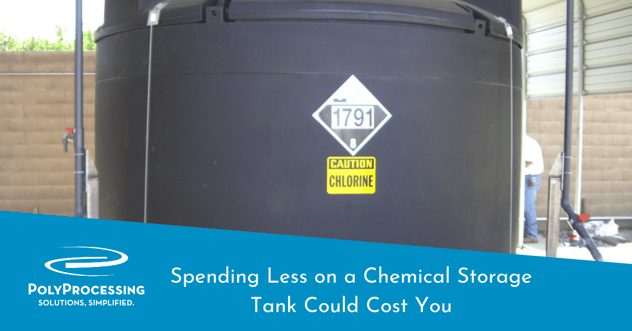Spending Less on a Chemical Storage Tank Could Cost You

You may spend a little more on a Poly Processing cross-linked polyethylene tank, but it could possibly cost much you more to own other tanks. Here’s why.
Doug Roughen at Core-Rosion Products put it beautifully:
“I was at my customer’s site yesterday in Corona, CA, as we delivered a 5000 gallon slope-bottom tank [for storing polymer]. His boss asked him why he pays a premium for a Poly Processing tank. They had bids for cheaper tanks. His response was that his first load of polymer will cost over $60,000. Why would he risk his product in an inferior tank, when the actual cost difference was minuscule over the life of the tank? Useful life-cost and risk outweigh initial costs, and he realizes it!!”
Let’s take a look at the useful life costs of your chemical storage tank.
How Long Will Your Chemical Tank Last?
For more than 40 years, Poly Processing Company has helped customers solve problems and manage risks associated with storing hazardous chemicals. We specialize in providing hazardous chemical storage tank solutions to the industrial, water, and wastewater markets.
Fiberglass storage tanks typically offer a limited one-year warranty period. The industry standard for polyethylene chemical storage tanks is three years unless you pay for an extended warranty.
In contrast, our cross-linked polyethylene tanks in most cases carry a full 5-year warranty and can last an average of three times longer than linear polyethylene tanks in the same application. Our customers often report that Poly tanks provide 15 to 20+ years of service.
If you’re searching for effective chemical storage, you’ll need long-lasting storage tanks to keep your personnel and your plant safe. Over time, new innovations have led to the development of advanced technology to accomplish this goal. In order to create very safe, long-lasting storage tanks, cross-linked polyethylene (XLPE) has become an ideal material to be used in chemical storage vessels.
Superior Life Expectancy of XLPE Tanks
Since cross-linked polyethylene has much stronger polymer connections, (the polymer chains are bonded molecularly), the life expectancy of tanks manufactured from XLPE is usually significantly longer than tanks that use standard kinds of polyethylene. XLPE is an engineered resin that is intentionally designed to be as long-lasting as possible, whereas standard polyethylene is more of a commodity material that is simpler and cheaper to produce.
Although it is impossible to determine exactly how long a storage tank will last, history proves that our XLPE tanks in most cases will give the end user greater useful life over linear polyethylene tanks in the same service, which makes them the optimal choice for those that put a high priority on the durability of their storage tanks.
The Structure of Cross-Linked Polyethylene
Cross-linked polyethylene is a thermoset, meaning it cannot be reshaped after it cures. This means that the polymer chains connect in a much stronger way than chains in linear polyethylene. Because of this unique composition, it has to be manufactured differently than linear types of polyethylene. Curing a tank with XLPE has to take place in a much smaller window of time than normal polyethylene materials and takes highly trained personnel to assure a quality product each and every time.
The Best Business Decision for Chemical Storage
No matter what tank you buy, there’s a significant cost to installing and replacing a chemical storage tank. Many companies only calculate the tank purchase cost and shipping costs when deciding to purchase a new tank or replace an existing chemical storage tank. However, there are several additional factors to consider as well, including:
- Temporary day tank. If you need the chemical on a daily basis, you might bring in a smaller temporary tank while the new one is being manufactured and shipped.
- Backup tank. Sometimes we recommend purchasing a backup storage tank as well, to ensure that you have redundancy.
- Tank removal. Getting the old tank out of the building can be a large undertaking. A crew will need to disconnect the piping, pumps, and other accessories. The tank will need to be pulled out of the building—or, if it’s too large to pull through the doors, it will need to be cut up and removed.
- Installing the new tank. If the new tank is too large to maneuver through the entrances, you may need to remove the paneling or roofing, and lift the new tank inside the building with a crane. Also, the time and labor involved with plumbing can be very costly.
Whether you purchase a cheap tank or an expensive tank, it’s important to install the best chemical storage system for the greatest useful life. While Poly Processing XLPE tanks can have a slightly higher upfront cost, the lifetime investment means fewer costs and greater savings.
We pride ourselves on listening to the needs of our customers to help them find a chemical storage tank solution that fits within the specific requirements of each project that we are asked to help with.
If you'd like to learn more about high-density cross-linked polyethylene, get in touch with one of our chemical storage experts today.
- February 22, 2021
- Topics: Venting, Fittings and Accessories, Tank Design and Materials
About Poly Processing
Posts By Topic
Tech Talk Podcast Episodes
Subscribe By Email
Recent Posts
- Installation Tips for Chemical Storage Tanks: Site Preparation and Offloading
- Understanding pH and Chemical Concentration When Choosing a Chemical Tank
- Maximizing Fill Efficiency: Selecting the Optimal Fill Line System
- Chemical Storage Tanks: A Quick Guide for End Users
- Popular Customization Options for Chemical Storage Tanks
Tank Configurator

Find the recommended tank and system components for your chemical storage challenge.
Configure a Tank Package



